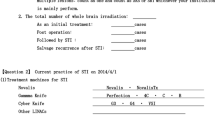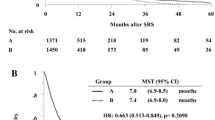Abstract
Objective A comparison of treatment parameters and quality of clinical outcome in patients with single brain metastases treated with two different technologies for radiosurgery (Gamma Knife and CyberKnife). Methods Treatment parameters were statistically analyzed. Clinical outcome was assessed by matched-pair analysis based on the treatment device, differences in dose prescription, and the date of the treatment. Patients were matched according to their tumor size, age, gender, primary cancer, and Radiation Therapy Oncology Group score. Survival post-radiosurgery, local and distant tumor control, and complications were analyzed. Predictive factors were investigated. Results 423 single brain metastases were treated with Gamma Knife and 73 with CyberKnife. Tumor volumes were similar. The parameters minimum tumor dose, maximum tumor dose, prescription isodose volume, conformality index, homogeneity index, volume of tissue receiving a dose of 10 Gy or more were significantly larger in Gamma Knife group. Sixty-three patients were good matches. These showed the same pattern in parameters. Concerning the outcome analysis, only overall survival differed significantly between groups, twice as long with CyberKnife (P < 0.03). According to pooled data, dose was predictive of local failure, whole brain radiation therapy and chemotherapy were predictive of toxicity, the Radiation Therapy Oncology Group score was predictive of survival after radiosurgery, and date of treatment was predictive of overall survival. No factor predicted new brain metastases, including whole brain radiation therapy. Conclusions The most important result of this study was the finding that the obvious differences in treatment-related parameters between Gamma Knife and CyberKnife had no impact on the quality of the clinical outcome after radiosurgery. Survival time increased chronologically, presumably due to an intensified anti-cancer therapy in the more recent era of the CyberKnife treatments.




Similar content being viewed by others
Abbreviations
- ARE:
-
adverse radiation reaction
- CFI:
-
conformality index
- CI:
-
confidence interval
- CK:
-
CyberKnife
- Dmax:
-
maximum tumor dose
- Dmin:
-
minimum tumor dose
- GK:
-
Gamma Knife
- PIV:
-
prescription isodose volume
- HI:
-
homogeneity index
- KPS:
-
Karnofsky’s performance score
- Pt:
-
Platinum
- QA:
-
quality assurance
- RS:
-
radiosurgery
- RTOG:
-
Radiation Therapy Oncology Group
- Tvol:
-
tumor volume
- WBRT:
-
whole brain radiation therapy
- V10:
-
volume of tissue receiving a dose of 10 Gy or more
- V10net:
-
V10 minus tumor volume
References
Leksell L (1951) The stereotaxic method and radiosurgery of the brain. Acta Chir Scand 102:316–319
Sturm V, Kober B, Hover KH, Schlegel W, Boesecke R, Pastyr O, Hartmann GH, Schabbert S, zum Winkel K, Kunze S et al (1987) Stereotactic percutaneous single dose irradiation of brain metastases with a linear accelerator. Int J Radiat Oncol Biol Phys 13:279–282
Smith ML, Lee JY (2007) Stereotactic radiosurgery in the management of brain metastasis. Neurosurg Focus 22:E5. doi:10.3171/foc.2007.22.3.6
Flickinger JC, Lunsford LD, Kondziolka D, Maitz A (1993) Potential human error in setting stereotactic coordinates for radiosurgery - implications for quality assurance. Int J Radiat Oncol Biol Phys 27:397–401
Hartmann GH (1994) Quality assurance programme on stereotactic radiosurgery. Acta Neurochir Suppl (Wien) 62:98–100
Treuer H, Hoevels M, Luyken K, Gierich A, Kocher M, Muller RP, Sturm V (2000) On isocentre adjustment and quality control in linear accelerator based radiosurgery with circular collimators and room lasers. Phys Med Biol 45:2331–2342. doi:10.1088/0031-9155/45/8/318
Mack A, Czempiel H, Kreiner HJ, Durr G, Wowra B (2002) Quality assurance in stereotactic space. A system test for verifying the accuracy of aim in radiosurgery. Med Phys 29:561–568. doi:10.1118/1.1463062
Schell MC, Kooy H (1994) Stereotactic radiosurgery quality improvement: interdepartmental collaboration. Int J Radiat Oncol Biol Phys 28:551–552. doi:editorial;comment
Shaw E, Kline R, Gillin M, Souhami L, Hirschfeld A, Dinapoli R, Martin L (1993) Radiation Therapy Oncology Group: radiosurgery quality assurance guidelines. Int J Radiat Oncol Biol Phys 27:1231–1239
Muacevic A, Jess-Hempen A, Tonn JC, Wowra B (2004) Clinical quality standards for gamma knife radiosurgery–the Munich protocol. Acta Neurochir Suppl (Wien) 91:25–32
Adler JR Jr, Chang SD, Murphy MJ, Doty J, Geis P, Hancock SL (1997) The Cyberknife: a frameless robotic system for radiosurgery. Stereotact Funct Neurosurg 69:124–128. doi:10.1159/000099863
Chang SD, Main W, Martin DP, Gibbs IC, Heilbrun MP (2003) An Analysis of the Accuracy of the CyberKnife: A Robotic Frameless Stereotactic Radiosurgical System. Neurosurgery 52:140–147. doi:10.1097/00006123-200301000-00018
Yu C, Main W, Taylor D, Kuduvalli G, Apuzzo ML, Adler JR Jr (2004) An anthropomorphic phantom study of the accuracy of Cyberknife spinal radiosurgery. Neurosurgery 55:1138–1149. doi:10.1227/01.NEU.0000141080.54647.11
Gaspar L, Scott C, Rotman M, Asbell S, Phillips T, Wasserman T, McKenna WG, Byhardt R (1997) Recursive Partitioning Analysis (RPA) of Prognostic Factors in Three Radiation Therapy Oncology Group (RTOG) Brain Metastases Trials. Int J Radiat Oncol Biol Phys 37:745–751. doi:10.1016/S0360-3016(96)00619-0
Gaspar LE, Scott C, Murray K, Curran W (2000) Validation of the RTOG recursive partitioning analysis (RPA) classification for brain metastases. Int J Radiat Oncol Biol Phys 47:1001–1006. doi:10.1016/S0360-3016(00)00547-2
Arndt J (1993) Focussed gamma radiation. The Gamma Knife. In: Phillips MH (ed) Physical aspects of stereotactic radiosurgery. Plenum Press, New York, pp 87–128
Muacevic A, Kreth FW, Horstmann GA, Schmid-Elsaesser R, Wowra B, Steiger HJ, Reulen HJ (1999) Surgery and radiotherapy compared with gamma knife radiosurgery in the treatment of solitary cerebral metastases of small diameter. J Neurosurg 91:35–43
Muacevic A, Kreth FW, Mack A, Tonn JC, Wowra B (2004) Stereotactic radiosurgery without radiation therapy providing high local tumor control of multiple brain metastases from renal cell carcinoma. Minim Invasive Neurosurg 47:203–208. doi:10.1055/s-2004-818511
Muacevic A, Kreth FW, Tonn JC, Wowra B (2004) Stereotactic radiosurgery for multiple brain metastases from breast carcinoma. Cancer 100:1705–1711. doi:10.1002/cncr.20167
Muacevic A, Siebels M, Tonn JC, Wowra B (2005) Treatment of brain metastases in renal cell carcinoma: radiotherapy, radiosurgery, or surgery? World J Urol 23:180–184
Muacevic A, Wowra B, Siefert A, Tonn JC, Steiger HJ, Kreth FW (2007) Microsurgery plus whole brain irradiation versus Gamma Knife surgery alone for treatment of single metastases to the brain: a randomized controlled multicentre phase III trial. J Neurooncol 87:299–307
Wowra B, Muacevic A, Jess-Hempen A, Tonn JC (2004) Safety and efficacy of outpatient gamma knife radiosurgery for multiple cerebral metastases. Expert Rev Neurother 4:673–679. doi:10.1586/14737175.4.4.673
Wowra B, Siebels M, Muacevic A, Kreth FW, Mack A, Hofstetter A (2002) Repeated gamma knife surgery for multiple brain metastases from renal cell carcinoma. J Neurosurg 97:785–793
Yu C, Jozsef G, Apuzzo ML, Petrovich Z (2003) Dosimetric comparison of CyberKnife with other radiosurgical modalities for an ellipsoidal target. Neurosurgery 53: 1155–1162; Discussion 1162–1153
Flickinger JC, Lunsford LD, Wu A, Maitz AH, Kalend AM (1990) Treatment planning for gamma knife radiosurgery with multiple isocenters. Int J Radiat Oncol Biol Phys 18:1495–1501
Leith JT, Cook S, Chougule P, Calabresi P, Wahlberg L, Lindquist C, Epstein M (1994) Intrinsic and extrinsic characteristics of human tumors relevant to radiosurgery: comparative cellular radiosensitivity and hypoxic percentages. Acta Neurochir Suppl (Wien) 62:18–27
Collins SP, Coppa ND, Zhang Y, Collins BT, McRae DA, Jean WC (2006) CyberKnife radiosurgery in the treatment of complex skull base tumors: analysis of treatment planning parameters. Radiat Oncol 1:46. doi:10.1186/1748-717X-1-46
Petti PL, Chuang CF, Smith V, Larson DA (2006) Peripheral doses in CyberKnife radiosurgery. Med Phys 33:1770–1779. doi:10.1118/1.2198173
Voges J, Treuer H, Sturm V, Buchner C, Lehrke R, Kocher M, Staar S, Kuchta J, Muller RP (1996) Risk analysis of linear accelerator radiosurgery. Int J Radiat Oncol Biol Phys 36:1055–1063. doi:10.1016/S0360-3016(96)00422-1
Nataf F, Schlienger M, Liu Z, Foulquier JN, Gres B, Orthuon A, Vannetzel JM, Escudier B, Meder JF, Roux FX, Touboul E (2008) Radiosurgery With or Without A 2-mm Margin for 93 Single Brain Metastases. Int J Radiat Oncol Biol Phys 70:766–772. doi:10.1016/j.ijrobp.2007.11.002
Auchter RM, Lamond JP, Alexander E, Buatti JM, Chappell R, Friedman WA, Kinsella TJ, Levin AB, Noyes WR, Schultz CJ, Loeffler JS, Mehta MP (1996) A multiinstitutional outcome and prognostic factor analysis of radiosurgery for resectable single brain metastasis. Int J Radiat Oncol Biol Phys 35:27–35. doi:10.1016/S0360-3016(96)85008-5 see comments
Fernandez-Vicioso E, Suh JH, Kupelian PA, Sohn JW, Barnett GH (1997) Analysis of prognostic factors for patients with single brain metastasis treated with stereotactic radiosurgery. Radiat Oncol Investig 5:31–37. doi:10.1002/(SICI)1520-6823(1997)5:1<31::AID-ROI5>3.0.CO;2-L
Yamanaka K (1999) Prognostic factors for brain metastasis from lung cancer after gamma knife radiosurgery. Osaka City Med J 45:45–59
Aoyama H, Shirato H, Tago M, Nakagawa K, Toyoda T, Hatano K, Kenjyo M, Oya N, Hirota S, Shioura H, Kunieda E, Inomata T, Hayakawa K, Katoh N, Kobashi G (2006) Stereotactic radiosurgery plus whole-brain radiation therapy vs stereotactic radiosurgery alone for treatment of brain metastases: a randomized controlled trial. JAMA 295:2483–2491. doi:10.1001/jama.295.21.2483
Ho AK, Fu D, Cotrutz C, Hancock SL, Chang SD, Gibbs IC, Maurer CR Jr, Adler JR Jr (2007) A Study of the Accuracy of Cyberknife Spinal Radiosurgery Using Skeletal Structure Tracking. Neurosurgery 60:147–156. doi:10.1227/01.NEU.0000249248.55923.EC
Muacevic A, Drexler C, Wowra B, Schweikard A, Schlaefer A, Hoffmann RT, Wilkowski R, Winter H, Reiser M (2007) Technical description, phantom accuracy, and clinical feasibility for single-session lung radiosurgery using robotic image-guided real-time respiratory tumor tracking. Technol Cancer Res Treat 6:321–328
Muacevic A, Staehler M, Drexler C, Wowra B, Reiser M, Tonn JC (2006) Technical description, phantom accuracy, and clinical feasibility for fiducial-free frameless real-time image-guided spinal radiosurgery. J Neurosurg Spine 5:303–312. doi:10.3171/spi.2006.5.4.303
Author information
Authors and Affiliations
Corresponding author
Rights and permissions
About this article
Cite this article
Wowra, B., Muacevic, A. & Tonn, JC. Quality of radiosurgery for single brain metastases with respect to treatment technology: a matched-pair analysis. J Neurooncol 94, 69–77 (2009). https://doi.org/10.1007/s11060-009-9802-y
Received:
Accepted:
Published:
Issue Date:
DOI: https://doi.org/10.1007/s11060-009-9802-y




